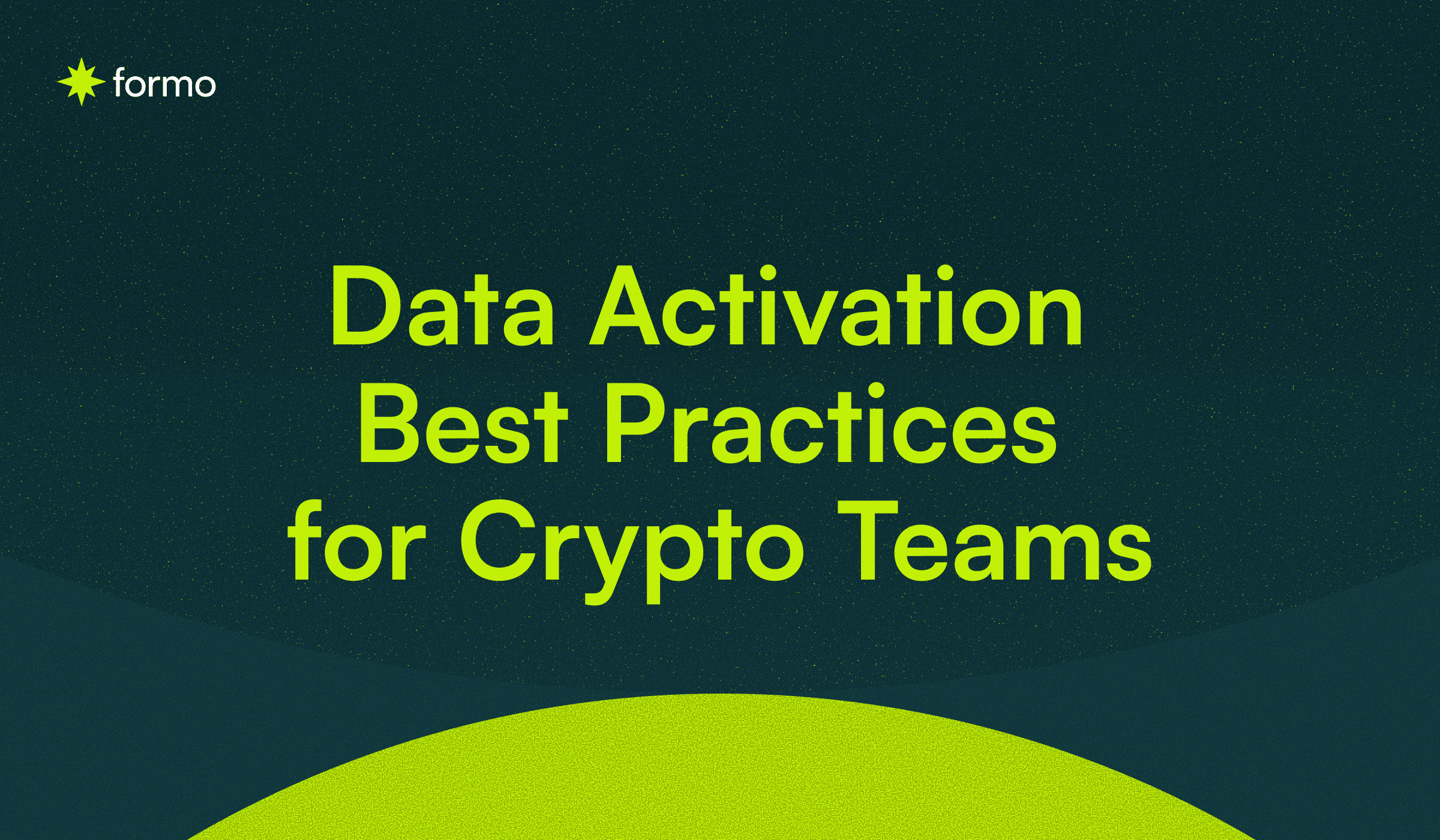In today’s digital age, concerns around data privacy and frequent data breaches make users hesitant to share personal information—especially in surveys. For crypto startups and onchain apps, gaining honest feedback without compromising privacy is a growing challenge.

Anonymous surveys help users trust and feel more comfortable in providing honest feedback
That’s where anonymous surveys come in. Designed to protect respondents' identities, they enable open, unbiased participation by removing the fear of being tracked or judged.
Anonymous surveys overcome these barriers to gather candid, unbiased responses. This guide walks you through how to create effective anonymous surveys that drive higher response rates, surface valuable insights, and build stronger user trust—all while aligning with the privacy-first principles of Web3.
Key Takeaways
Anonymous surveys encourage honest feedback by protecting respondent privacy and removing fear of judgment.
They are essential in Web3, where users value pseudonymity and privacy.
Higher response rates come from trust, transparency, and non-intrusive data collection.
Clarity, simplicity, and privacy-focused tools improve survey effectiveness and completion rates.
Platforms like Formo enable Web3 teams to gather zero-party data without compromising user privacy.
What are Anonymous Surveys?
Anonymous surveys are a set of questions designed to collect feedback without capturing identifiable personal information such as names, contact details, or locations. Research from USC and California State University indicates that private surveys encourage more truthful answers, as respondents feel more secure when their identities are protected.
Why Anonymous Surveys Matter

Best uses of anonymous surveys for crypto startups
They encourage honest feedback: When users know they can’t be identified, they’re more likely to speak openly—especially about sensitive or critical topics.
They improve completion rates: Removing personal questions lowers the friction to start and finish a survey.
They align with Web3 values: Privacy, user control, and transparency are core to the decentralized internet. Anonymous surveys reinforce these principles.
6 Benefits of Anonymous Surveys
Anonymous surveys offer several strategic advantages that can enhance the quality of the data collected and improve respondent engagement:

6 Key benefits of anonymous surveys to boost user retention
Encourages open dialogue
When respondents are assured of anonymity, they are more likely to share honest opinions, which can lead to deeper insights.
Boosts response rates
The assurance of anonymity reduces anxiety around participation, leading to higher response rates and more representative data.
Secures honest feedback
Anonymity empowers respondents to discuss sensitive or critical issues freely, providing organizations with a clearer understanding of underlying challenges.
Minimizes response bias
By eliminating the fear of repercussions, anonymous surveys help to reduce bias, ensuring that responses reflect true sentiments.
Facilitates problem identification
Honest, unfiltered feedback helps organizations identify key issues, from bad user experience to finding the era to improve products.
Enhances user satisfaction
Addressing the concerns raised through anonymous feedback can lead to increased satisfaction and a stronger, more positive community.
Anonymous vs. Confidential Surveys

The main differences between Anonymous and Confidential Surveys
It’s easy to confuse the two, but they’re not the same. Confidential surveys link responses to personal information, but only selected administrators can access this data.
Survey Type | What It Means | User Trust Level |
Anonymous | No identity is collected or stored. | Highest |
Confidential | Identity may be known but is kept private. | Moderate |
For privacy-first brands, anonymous surveys are often the best fit—especially for feedback, user research, and onboarding questions.
8 Tips to Create High-Converting Anonymous Surveys

8 Tips to create the best anonymous surveys and enhance your user experiences
1. Define a Clear Goal
Know exactly what you want to learn from the survey—whether it’s improving a product feature, validating a new idea, or understanding user pain points. A clear purpose keeps your questions focused and relevant.
2. Keep It Short and Focused
Long surveys cause drop-offs. Aim for 3–7 questions max, grouped by theme. Shorter forms with clear progression make it easier for users to complete without losing interest.
3. Ask Neutral, Non-Leading Questions
Avoid questions that imply a “right” answer. Let respondents express their true thoughts without pressure or bias. Use open-ended formats like:
“What was most frustrating about your last experience?”
“Any suggestions to make this product better?”
Avoid double-barreled questions that ask about two different things at once (e.g., “How satisfied are you with the quality and speed of our service?”) This can confuse respondents and lead to unclear or misleading responses.
4. Don’t Ask for Personal Information
Avoid asking for names, emails, wallet addresses, or social handles. These are Personally Identifiable Information (PII) and are subject to privacy laws in some jurisdictions. If you must collect basic info, make it optional and explain why.
If necessary, ask demographic questions in broad categories (e.g., age ranges) rather than specific details that could potentially identify respondents.
5. Use Privacy-First Survey Tools
Choose tools that support:
No data tracking
Optional wallet gating
No IP or cookie storage
Adhere to data protection standards such as GDPR or similar regulations in your region. Compliance involves implementing measures to protect respondent data and maintaining transparency about how data is used.
Platforms like Formo are purpose-built for anonymous surveys in Web3.
6. Offer Context Before the Survey Starts
Let people know upfront:
Why you’re asking for feedback
How their answers will be used
That their responses are 100% anonymous
This sets expectations and builds trust.
7. Add a Thank-You Message
Acknowledge their time and contribution with a simple thank-you message or success screen after submission. You can even redirect them to a helpful link or community space.
8. Add Security Layers
Utilize tools such as reCAPTCHA to prevent automated bots from submitting responses. These security features help filter out spam and ensure that the data collected is from legitimate participants.

Basic steps to create anonymous surveys
Common Use Cases for Anonymous Surveys
Product feedback and feature validation
Bug reports and user experience audits
Community pulse checks and sentiment tracking
Internal team retrospectives or contributor feedback
Governance and DAO voting sentiment surveys
Anonymous surveys aren’t just a “nice-to-have”—they’re a must-have for teams that value user trust, honest insights, and clean data. Especially in Web3, where identities are pseudonymous by default, anonymity unlocks powerful opportunities for growth, product development, and community building.
Capture Actionable User Feedback with Formo
Unlock the power of anonymous surveys to drive authentic participation and gain reliable insights. From refining product development to enhancing user experience and community engagement, anonymity fosters honest feedback that fuels meaningful product improvements.

Collect actionable insights and enhance your onchain marketing strategy with Formo
By using Web3 Forms and following best practices, you can design surveys that people want to complete—and that give you the insights you need to move fast and build better products.
Follow us on LinkedIn and Twitter, and join our community to learn how onchain teams turn data into action with Formo!
Read more:
FAQs
1. What is an anonymous survey?
An anonymous survey doesn’t collect any personally identifiable information (PII), like names, emails, or IP addresses. An effective anonymous survey does not link responses to individuals and ensures that both the platform and researchers have no access to respondent identities. Responses can’t be traced back to individuals, which encourages honest and unbiased feedback.
2. Why are anonymous surveys important in Web3?
Web3 users value privacy and often use pseudonymous wallets. Anonymous surveys align with these principles, helping projects build trust, increase response rates, and gather genuine insights without compromising user identity.
3. How is an anonymous survey different from a confidential one?
Anonymous surveys collect no identity data at all. In contrast, confidential surveys may collect PII, but keep it protected. Use anonymous surveys when you want full privacy.
4. Can I still get useful insights from anonymous surveys?
Yes. Frame demographic questions broadly (e.g., “Age range” instead of exact age) and avoid combining multiple identifiers. This allows you to gather insights without risking the privacy of respondents.
You can analyze trends, group responses by behavior (if opt-in), and gather qualitative insights—all without needing personal data. This makes anonymous surveys ideal for community surveys and product feedback.
5. What tools support anonymous survey creation? Use platforms that don’t track IPs, store cookies, or require logins. Formo, for example, is designed for Web3—supporting anonymous responses, token gating, and full privacy compliance.





